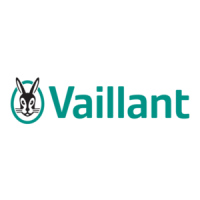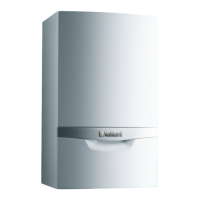
Do you have a question about the Vaillant VU 186/6-5 OVZ (H-GB) ecoTEC plus 418 and is the answer not in the manual?
| Model | VU 186/6-5 OVZ (H-GB) ecoTEC plus 418 |
|---|---|
| Nominal Heat Output | 18 kW |
| Efficiency | up to 98% |
| Fuel Type | Natural gas |
| DHW Production | Yes |
| Dimensions (H x W x D) | 720 x 440 x 338 mm |
| Mounting | Wall-mounted |
| Warranty | 2 years |
| Energy efficiency class | A |
| Type | Gas condensing boiler |
Specifies the product's intended application as a heat generator for heating and hot water.
Details the professional training and skills required for installation and maintenance.
Provides critical safety advice on gas, flue gas, electricity, weight, and hazardous substances.
Outlines the need to observe national regulations, directives, laws, and specific standards.
Instructions for registering the appliance to validate the warranty and contact details.
Lists key parameters like gas category, pipe diameters, pressure, and efficiency.
Provides detailed performance data for heating and hot water output, flow rates, and temperatures.
Details electrical connection requirements, fuse ratings, and power consumption.
Explains the CE marking significance and conformity to directives.
Information on identifying the product via serial number and data plate details.
Identifies and describes the main components and features of the appliance.
Details the built-in safety mechanisms like frost protection and overheating shutdown.
Checks contents of delivery and provides product dimensions for installation planning.
Specifies suitable locations for installing the boiler, considering regulations and room types.
Defines required space around the unit and ventilation needs for safe operation.
Covers regulations and requirements for installing the air and flue pipe system.
Details specific distances and siting requirements for air/flue terminals.
Provides guidance on positioning horizontal flue terminals to avoid nuisance and ensure safety.
Describes different flue types like concentric and multiple boiler systems.
Instructions for using templates and securely mounting the appliance to the wall.
Procedures for removing and refitting the front and side casings for access.
Ensures readiness of gas supply, pipelines, and installation of key components.
Guidance on installing the heating pump, considering pressure loss and flow rates.
Details how to connect the heating water supply for open (vented) systems.
Explains water supply connections for sealed heating systems, including vessel sizing.
Checks if the product is compatible with the local gas type available at the installation site.
Steps for establishing a secure and compliant gas connection, including purging and leak checks.
Instructions for connecting the condensate pipe, ensuring free flow and frost protection.
Guidance on installing the air/flue pipe system and positioning the terminal.
Covers essential electrical connection steps, safety precautions, and cable routing.
Details the process of safely connecting the product to the electrical power supply.
Instructions for connecting the heating pump to the boiler's control system.
Explains how to connect various controls like thermostats and sensors to the appliance's electronics.
Describes how to operate the appliance and navigate its menus for the end user.
Guides on entering installer settings and viewing real-time operating status codes.
Outlines the initial start-up process and the requirement to complete the Benchmark checklist.
Details checks and treatments for heating water quality to prevent corrosion and damage.
Procedure for filling the condensate trap with water to ensure proper function.
Steps for flushing the heating installation with cold water as part of the initial start-up.
Guides on switching on the product and running the automated installation assistants.
How to re-run the installation assistant for setup adjustments or re-checks.
Lists available test programmes for start-up, maintenance, and troubleshooting.
Instructions on how to fill the heating installation with water.
Procedures for verifying gas settings, flow rates, and combustion parameters.
Steps for flushing the heating installation with hot water after initial filling.
Procedures for checking the tightness of gas, heating, and hot water circuits.
Configuration of the burner anti-cycling time to optimize operation and prevent short cycling.
Key information and actions required when transferring the appliance to the end user.
Guidelines on completing service records and using original replacement seals.
Procedures for measuring and adjusting the CO2 content for optimal combustion.
Step-by-step instructions for removing the gas-air mixture unit for maintenance.
Instructions for cleaning the heat exchanger to maintain efficiency and performance.
Procedures for inspecting the burner and ignition electrode for damage or wear.
Steps for cleaning the condensate trap and installing the gas-air mixture unit.
Procedures for draining the product and finalizing inspection and maintenance tasks.
Guidance on identifying, clearing, and managing fault codes and memory.
Steps for preparing for repairs, including decommissioning and sourcing spare parts.
Detailed instructions for replacing key components like the burner, heat exchanger, and gas-air unit.
Final check to ensure the product and its connections are leak-tight.
Instructions for the correct disposal of the product's packaging materials.
Lists required inspection and maintenance tasks with their recommended intervals.
Provides a detailed overview of the installer menu, settings, and test programmes.
Lists and explains various diagnostic codes used for system configuration and troubleshooting.
Explains the different status codes displayed by the appliance during operation.
Lists and explains potential fault codes, their causes, and possible solutions.
Illustrates the electrical connections and layout of the appliance's internal wiring.
Specific wiring diagram tailored for the 30 kW model of the appliance.
Document for recording installation, commissioning, and warranty validation details.











